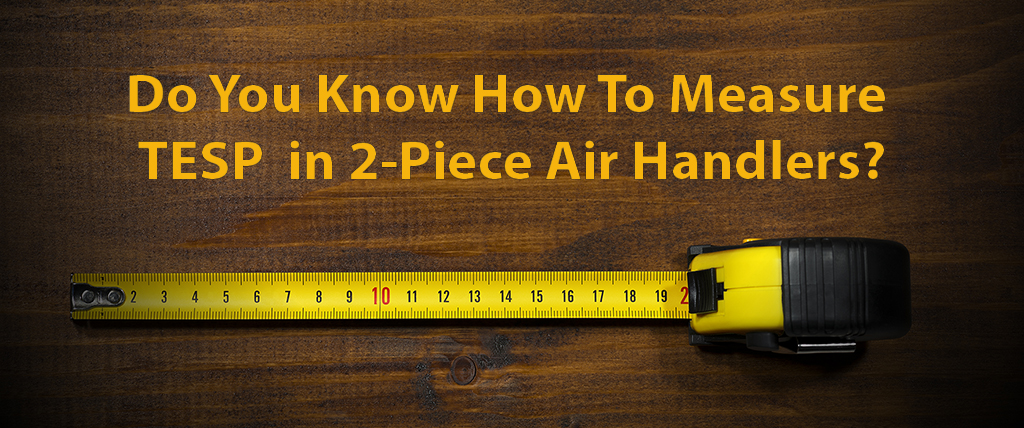
David Richardson is a Curriculum Developer & Instructor for National Comfort Institute, Inc.
What makes modular or two-piece different from their single-piece cousins when it comes to measuring total external static pressure (TESP)? In this article we’ll examine the differences and discuss how to measure TESP correctly.
“As-Shipped”
The “As-Shipped” idea is helpful when measuring the TESP of two-piece air handlers. So, what do you find when you unpackage a two-piece air handler from the factory, “as-shipped?” For those familiar with this equipment, you know the box only includes the blower section. The coil, filter, and electric heat strips (if equipped) ship in separate containers.
To avoid any confusion, consider what happens to the blower and coil sections once you unbox them at the job site. Typically you have to field-assemble the two pieces to form the air handler. So even though you combine the sections in the field, the “as-shipped” portion is the blower section only. This is how the manufacturer rated the equipment in the laboratory, not with a coil attached.
The Coil
Don’t treat the coil in a two-piece air handler as an internal pressure drop. Handle the coil just like a gas furnace – it is external. This means you must account for the pressure drop of the coil when you measure. I’ve seen many technicians accidentally include the coil as an internal pressure drop on this air handler style and get inaccurate readings.
It’s important to note that cased coils used with two-piece air handlers have pressure drop data available for them. With this information, compare the coil’s rated pressure drop against your measured coil pressure drop. The difference shows whether the coil is dirty or restricted. This isn’t a something you can do with single-piece air handlers.
The Air Filter
Two-piece air handlers do not include a factory air filter. This means you need to field install it as an add-on accessory. Just like the coil, the air filter is external, and you need to account for its pressure drop when measuring total external static pressure.
Electric Heat Strips
Electric heat strips typically don’t influence airflow enough in a residential air handler to worry about them. Whatever you do, don’t try to measure pressure drop across the heater. You might get electrocuted by trying to obtain a reading that doesn’t have much value.
Measuring Total External Static Pressure
Once you understand these factors, you’ll need to install two test ports for pressure measurement. The following steps are for TESP only.
- Install a 3/8” test port into the blower section, on the exiting air side of the coil. This is your pressure measurement after the coil, just before air enters the blower. Inspect before you drill — you don’t want to accidentally drill into the coil.
- Install a 3/8” test port into the supply duct on the leaving air side of the equipment (supply plenum). This is your pressure measurement as air leaves the blower section. Try to get this reading about 12 inches away from the cabinet. You may pick up fan turbulence and obtain an inaccurate reading if you’re too close to the fan discharge.
- Turn on your digital manometer, or if using an analog manometer, level and zero it.
- Attach a hose to each pressure tap of the manometer. Then insert a static pressure tip into the opposite end of each of those hoses.
- Insert the static pressure tip — attached to the hose going to the (+) port of the manometer or the (high) port of the Magnehelic — into the 3/8” port you installed in the supply plenum.
- Insert the other static pressure tip – the one attached to the hose going to the (-) port of the manometer or (low) port of the Magnehelic — into the 3/8” port you installed after the coil.
- The measured TESP reading will appear on the display of the manometer.
- Read and record the measured TESP.
Diagnose the TESP Reading
Ideally, the measured TESP reading should not exceed the maximum rated TESP of the air handler. You typically typically find this rating on the data plate located on the blower section’s door.
Compare the measured TESP reading against the maximum-rated TESP. Most two-piece air handlers are rated for .50” w.c. (inches of water column). In this example, the measured TESP reading should not exceed .50” w.c. If it does, you could have problems. The typical air handler can’t move proper airflow when pressure is high.
Even though most two-piece air handlers are rated at .50” w.c., many models with constant-speed fans are equipped with weak fans. Because of this, they can barely move the needed amount of airflow once a coil, filter, and duct system is added to the blower section.
The best choice when using this style of air handler is to select a model equipped with a variable-speed fan. This gives you a little more fan strength to compensate for the pressure drop of the additional components.
David Richardson serves the HVAC industry as a curriculum developer and trainer at National Comfort Institute, Inc. (NCI). NCI specializes in training focused on improving, measuring, and verifying HVAC and Building Performance.
If you’re an HVAC contractor or technician interested in diagnosing and solving airflow problems, contact David at davidr@ncihvac.com or call him at 800-633-7058. NCI’s website — www.nationalcomfortinstitute.com — is full of free technical articles and downloads to help you improve your professionalism and strengthen your company.
